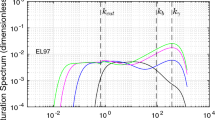Abstract
Variations of the wind-wave interaction coefficient for Bragg ripples have been calculated which allow the radar modulation transfer function (MTF) to be derived in view of the variations of wind flow over the long wave profile. It is shown that the wind component of the MTF is significant only for swell.
Similar content being viewed by others
References
Wright, J., Plant, W. J., Keller, W. C. and Jones, W. L. Ocean wave-radar modulation transfer function from West Coast experiments.J. Geophys. Res. (1980)85, 4957–4966.
Alpers, W. J., Ross, D. B. and Rufenach, C. L. On the detectability of ocean surface waves by real and synthetic aperture radar.J. Geophys. Res. (1981)86, 6481–6498.
Alpers, W. and Hasselman, K. The two-frequency microwave technique for measuring ocean-wave spectra from an airplane or satellite.Boundary-Layer Meteorol (1978)13, 215–230.
Schröter, J., Feindt, F., Alpers, W. and Keller, W. C. Measurements of the ocean wave-radar modulation transfer function at 4.3 GHz.J. Geophys. Res. (1986)191, 923–932.
Smith, J. Short surface waves with growth and dissipation.J. Geophys. Res. (1986)91, 2616–2632.
Makin, V. K. and Chalikov, D. V. Numerical modelling of the structure of air flow over the waves.Izv. Akad. Nauk SSSR, Fiz. Atmos. Okeana (1979)15, 292–299.
Makin, V. L. and Chalikov, D. V. Spectral structure of the boundary layer over the sea waves.Dokl. Akad. Nauk SSSR (1986),287, 706–711.
Makin, V. K. Dynamics and structure of the near-water layer over the sea. Doctoral thesis. Leningrad (1989), 417 p.
Larson, T. K. and Wright, I. W. Wind-generated gravity-capillary waves: laboratory measurements of temporal growth rates using microwave backscatter.J. Fluid Mech. (1975)70, 417–436.
Donelan, M. A. and Pierson, W. J. Radar scattering and equilibrium ranges in wind-generated waves with application to scatterometry.J. Geophys. Res. (1987)92, 4971–5029.
Additional information
Translated by Mikhail M. Trufanov.
Rights and permissions
About this article
Cite this article
Grodsky, S.A., Kudryavtsev, V.N. & Makin, V.K. Estimation of the contribution of wind variability to the ocean wave-radar modulation transfer function. Soviet Journal of Physical Oceanography 3, 17–26 (1992). https://doi.org/10.1007/BF02198489
Issue Date:
DOI: https://doi.org/10.1007/BF02198489




